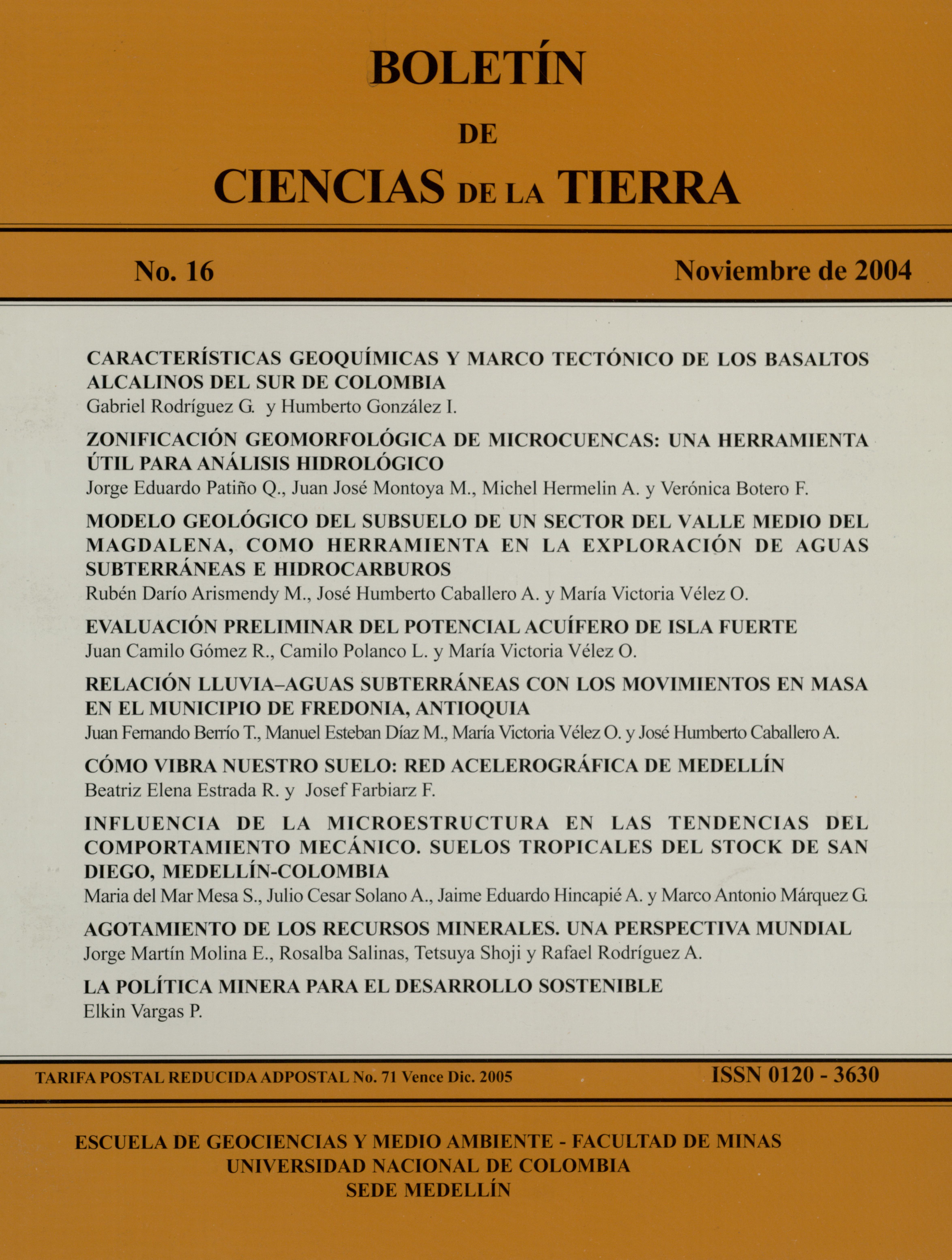Características geoquímicas y marco tectónico de los basaltos alcalinos del sur de Colombia
Keywords:
Basaltos Alcalinos, Geoquímica, Marco Tectonico-Colombia, Geología-Sur de Colombia (es)Alkali-Rich Basalts, Geochemistry, Tectonic Setting-Colombia (en)
Downloads
Afloramientos aislados de conos volcánicos y derrames de lavas basálticas alcalinas, se encuentran en el Sur de Colombia en posición tectónica similar con respecto a fallas regionales NNE. Las características petrográficas de las lavas basálticas alcalinas indican un alto contenido de máficos y en algunos casos ausencia de félsicos; están constituidas por clinopiroxeno, olivino, opacos y vidrio con trazas de plagioclasa, biotita, apatito y xenolitos de peridotitas con espinela provenientes del manto.
Análisis geoquímicos de algunas muestras confirman el carácter básico a ultrabásico de estas rocas, con SiO2 en muchos casos menor a 45%, MgO entre 10 y 14%, Fe2O3 entre 7 y 12% y de acuerdo a su composición química corresponden a nefelinitas, tefritas, basanitas nefelínicas, picrobasaltos y basaltos olivínicos alcalinos.
El origen de los basaltos alcalinos estaría relacionado al ascenso de un magma mantélico que alcanzó la superficie a través de estructuras regionales NNE, que levantaron el basamento de las cordilleras Oriental y Central, durante un periodo de distensión ocurrido durante el Plio-Pleistoceno al Holoceno que produjo un fracturamiento profundo en una cuenca trans-arco. Este vulcanismo sería independiente del andesítico generado por la zona de subducción y que está localizado al Occidente sobre la zona axial de la Cordillera Central.
Isolated volcanic cones and alkaline basalt flows crop out in southern Colombia, in a similar tectonic position relative to the regional NNE trending faults. The petrographic characteristics of the alkaline basalt lavas indicate a high mafic mineral content and in some instances a complete lack of felsic minerals. They comprise mainly clinopyeroxene, olivine, opaques and glass, with small amounts of plagioclase, biotite, apatite and spinel peridotite mantle xenoliths.
Geochemical analyses of some of the samples confirm the basic to ultrabasic character of these rocks, with SiO2 much less than 45%, MgO ranging from 10 to 14% and Fe2O3 from 7 and 12%. The chemical composition indicates that these rocks are nephelinites, tephrites, nepheline basanites, picrobasalts and alkaline olivine basalts.
The origin of the alkaline basalts is related to the ascent of magma formed in the mantle, which reached the surface through NNE trending regional structures. These structures elevated the Oriental and Central Cordillera basement, during a Plio-Pleistocene to Holocene period of distension, that produced deep-rooted fracturing in the back-arc basin. This volcanism is not related to the andesitic magmatism generated by the subduction zone, which is located towards the West, on the axis of the Central Cordillera.
References
Cárdenas, J., Núñez, A. y Fuquen, J., 2002. Geología de la Plancha 388-Pitalito. Ingeominas. 160 p. Bogotá.
INGEOMINAS y GEOESTUDIOS LTDA, 2001. Memoria explicativa del levantamiento geológico de la Plancha 389 Timaná. Escala 1:100.000. Ingeominas 116 p. Bogotá.
Kroonenberg, S. B.; León, L.; Pastana, J. y Pessoa, M., 1981. Ignimbritas pliopleistocénicas en el suroeste del Huila, Colombia y su influencia en el desarrollo morfológico. Revista CIAF, 6 (1-3): 293-314. Bogotá.
Kroonenberg, S. B.; Pichler, H. y Diederix, H., 1982. Cenozoic alkalibasaltic to ultrabasic volcanism in the uppermost Magdalena Valley, Southern Huila department, Colombia. Geologia Norandina, 5: 19-26. Bogotá.
Kroonenberg, S. B., Pichler, H., y Schmitt - Riegraf., C., 1987. Young alkalibasaltic to nephelinitic vulcanism in the southern Colombian Andes - Origin by subduction of a spreading rift? Zbl. Geol. Palaont. Teil., H7/8: 919-936 Stuttgart.
Kuno, H., 1966. Lateral variations of basalt magmas types across continental margins and island arcs. Bull. Volcanol., 29: 199-222.
Kuno, H., 1968. Differentiation of basalt magmas. In: Hess, H. & Poldervaart, A. (eds), Basalts: The Poldevaart treatise on rocks of basaltic composition. Vol. 2. Intrescience, New York, pp. 623 - 688.
Irvine T. y Baragar W., 1971. A guide to the chemical classification of the common volcanic rocks. Can. Journal Earth Sci.,8: 323-341.
Le Bas, M.; Le Maitre, R.; Streckeisen, A y Zanettib, B. 1986. A chemical classification of volcanic rocks based on the total alkali-silica diagram. Journal Petrol., 27(3): 745-750.
Mac Donald G y Katsura T., 1964. Chemical composition of Hawaiian lavas. Journal Petrol., 5: 83-133.
Núñez, A. y Gómez, J., 2003. Geología del Departamento del Putumayo. Ingeominas 241 p. Bogotá.
Rodríguez G., Zapata G., Velázquez M. E. y Cossio U., 2003. Geología de las planchas 367,368,389,390,414 y parte de la plancha 391. Ingeominas. 240 p. Bogotá
Streckeisen, A., 1978. Classification and nomenclature of volcanic rocks, lamprophyres, carbonatites, and melilitic rocks. Recomendations and suggestions of the IUGS Subcommision on the Systematics of Igneous Rocks. Geology. 7: 331-335.
Tello, H. y Hernández, T., 1976. Investigación geológica en el Parque Arqueológico de San Agustín (Huila). Tesis grado, U. Nal., Dep. Geoc., 30p. Bogotá.
How to Cite
APA
ACM
ACS
ABNT
Chicago
Harvard
IEEE
MLA
Turabian
Vancouver
Download Citation
Article abstract page views
Downloads
License

This work is licensed under a Creative Commons Attribution-NonCommercial-NoDerivatives 4.0 International License.
The author of a paper accepted for publication in any of the journals published by the School of Mines will yield all the property to the National University of Colombia rights free of charge, within which include article: the right to edit, publish, reproduce and distribute both print and digital media, as well as to include article in international indexes and / or databases, likewise, empowering the publisher to use images, tables and / or graphic material presented in Article for designing covers or posters of the magazine. By assuming economic rights of the article, may be reproduced partially or totally in any printed or digital media without express permission of the same.




















